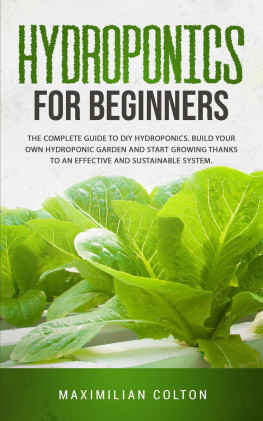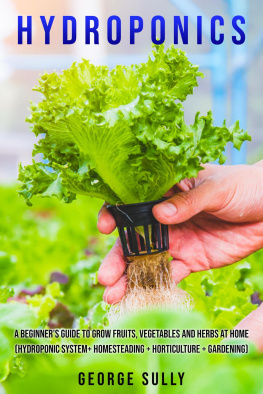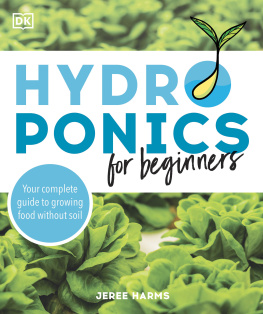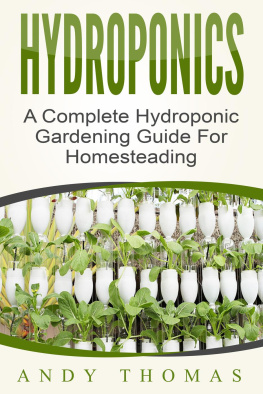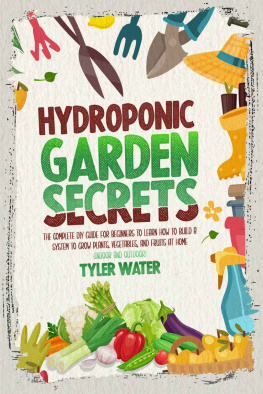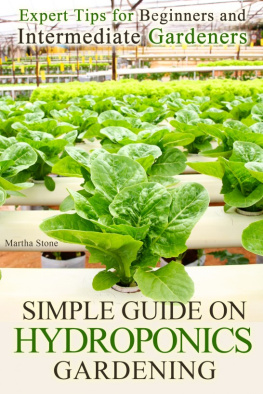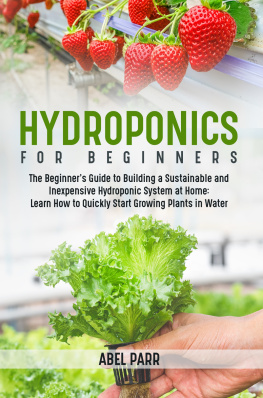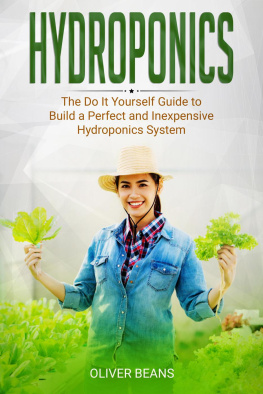HYDROPONICS
HYDROPONIC GARDENING GUIDE FROM BEGINNER TO EXPERT
Copyright 2016 - All rights reserved.
In no way is it legal to reproduce, duplicate, or transmit any part of this document in either electronic means or in printed format. Recording of this publication is strictly prohibited and any storage of this document is not allowed unless with written permission from the publisher. All rights reserved.
The information provided herein is stated to be truthful and consistent, in that any liability, in terms of inattention or otherwise, by any usage or abuse of any policies, processes, or directions contained within is the solitary and utter responsibility of the recipient reader. Under no circumstances will any legal responsibility or blame be held against the publisher for any reparation, damages, or monetary loss due to the information herein, either directly or indirectly.
Respective authors own all copyrights not held by the publisher.
Legal Notice:
This book is copyright protected. This is only for personal use. You cannot amend, distribute, sell, use, quote or paraphrase any part or the content within this book without the consent of the author or copyright owner. Legal action will be pursued if this is breached.
Disclaimer Notice:
Please note the information contained within this document is for educational and entertainment purposes only. Every attempt has been made to provide accurate, up to date and reliable complete information. No warranties of any kind are expressed or implied. Readers acknowledge that the author is not engaging in the rendering of legal, financial, medical or professional advice.
Table of Contents:
Introduction:
Chapter 2: The Different Hydroponic Systems
Chapter 3: Different Growing Mediums
Chapter 4: Nutrient Solutions
Chapter 5: What to Grow
Chapter 6: Pests and Diseases
Conclusion:
Introduction:
Hydroponics is the method of growing plants without soil by supplying them with a constant nutrient solution. Despite the fact that this method remains fairly unknown outside of a small sector of the horticultural world it has in fact been around for a long time. It is a system that was used extensively in the hanging gardens of Babylon and has been studied extensively by scientists and horticulturists for the last several hundred years.
There are many powerful reasons for commercial food growers to use this method but it is also now being used more frequently by the domestic gardener keen to produce a high yield in a small amount of space. Though it is seen primarily as a way of producing crops for the table it is also a method that can be used for the production of ornamental plants.
All plants require air, light, and dissolved nutrients to grow. Hydroponics allows for a very precisely controlled amount of nutrients, dissolved in water, to be administered directly to the root system as the plant requires it. Because the root system is no longer obliged to spread so far in order to attain the nutrients it requires this in turn enables the grower to plant his crops at much higher densities which is just one reason why hydroponic crop yields are so much greater than the more traditional soil planted yields.
There are a variety of variations on the hydroponic theme and this book will take a look at the main options the gardener has available to them. Though some of the methods might sound overly complicated for the home gardener I advise you to persist because what at first might appear a difficult system to reproduce is in fact surprisingly easy in many cases and the increase in yields will be staggering. I hope you enjoy the book.
Chapter 1: A Little History and Some Basic Principals
Primitive forms of hydroponics have been carried on by various societies for thousands of years. The word hydroponic itself stems from an amalgamation of two Ancient Greek words, hydro for water and ponic for work. In other words, the water was supposed to do the work that had created such toil for mankind ever since he began to practice agriculture.
Various forms of it have been carried on in Kashmir for centuries and one group, the Aztecs of America, developed a form of floating garden. Pushed to the marshy regions of Lake Tenochtitlan, in what is now Mexico, by other more aggressive tribes these nomadic people were forced to come up with a viable agricultural system in order to survive. They developed a system of floating rafts woven together out of reeds that eventually turned in to an archipelago of floating islands. These islands teemed with vegetables, flowers and even trees. The historian William Prescott recorded the destruction of the Aztec empire by the colonizing Spaniards and he described the floating gardens as Wondering islands of Verdure, teeming with flowers and vegetables and moving like rafts on the water.
Many historians believe that hydroponics was an important ingredient in the creation of the famous hanging gardens of Babylon which was one of the seven wonders of the Ancient World. If that is the case this is probably the first example of hydroponics being used as a farming method.
In more modern times the first scientific studies took place in the 1600s when the Belgian Jan van Helmont demonstrated that you could grow a willow in a tube containing 200 pounds of dried soil and fed only with rain water. After five years the willow shoot had obtained a weight of 160 pounds whilst the soil had only decreased in weight by two ounces. He concluded that plants obtain what they require for growth from water. Whilst partially correct in his assumptions, that early demonstration failed to take into account the need for carbon dioxide and oxygen which are also crucial to plant development.
In 1699 John Woodwards took the experiment a stage further when he grew plants in water which contained differing amounts of diluted soil. The plants that had the highest concentrates of soil grew best. In this early version of the man made hydroponic solution Woodwards realized that soil probably contained some nutrient crucial to plant growth but with chemistry not yet discovered he was unable to identify what those nutrients were.
Science began to gather momentum in the decades that followed and scientist were able to prove that plants absorbed water via their roots and that this then passed through their systems to be released through pores in the leaves. They also discovered that the roots also draw up nutrients and oxygen and that leaves draw carbon dioxide from the air.
In 1851 French scientist Jean Baptist Boussingault began experimenting with inert growing media and water with various combinations of elements available in soil. In 1860 the first nutrient solution in which plants could be grown was published by Professor Julius von Sachs. Various solutions continued to be developed but at this stage all studies had been based around laboratory research. It was not until the 1920s that Doctor William Gericke began to extend lab work to include outdoor crop production. In the process he termed the use of the word hydroponics and laid the groundwork for all forms of modern day hydroponics as we know it. Developments continued of course, and still today this is an evolving science but we now have a far better handle on the methodology of growing plants without the use of soil.
There are several major benefits to using this method to cultivate plants. We immediately eliminate soil borne pests and diseases. Greater control over the plants provides more consistent size and production. Water waste is massively reduced since the water is reused. Crops mature more rapidly often allowing for two crops per year where only one is possible in traditional soil growing systems and finally greater yields are produced. In a world with decreasing natural resources and a rapidly increasing population growth it is almost inevitable that this will be an area of agricultural production that sees massive growth.
Next page

